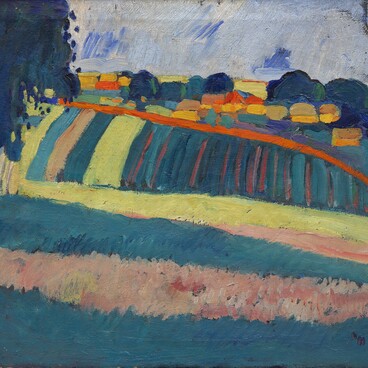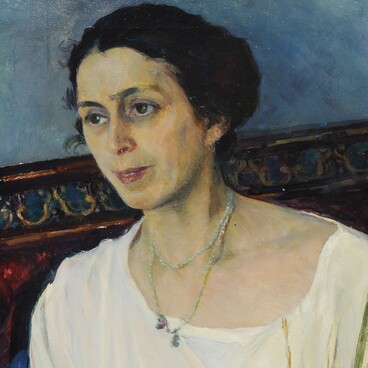The formation of Aleksander Grigoryevich Tyshler as an artist coincided with the heyday of Russian avant- garde in the first quarter of the 20th century. He did not become a follower of any ‘new’ art movement, but created his own original type of painting, with a completely specific range of themes and interpretations, and with its intrinsic color and compositional system. But this does not mean that avant-garde, just like impressionism and symbolism, did not influence his work. Researchers note the impact that the works done by Chagall and Vrubel had on him. But in fact the artist so organically, almost intuitively, synthesizes elements of cubism, the opacity of impressionism, the uncertainty of symbolism, the contrasting effect of expressionism, and the terseness of primitivism that this does not allow classifying his painting under this or that ‘ism’.
Symbolism, theatricality, generalization, the canonicity of the images, the monumental stability of the plasticity and the philosophical and romantic fullness - there features are inherent in the Portrait of a Lady, and in other works by Tyshler, that correspond to his views on the problems involved in easel art. No painting by Tyshler is merely an image, but is always a symbol, a sign that it is difficult to express in words: a dream, fear, grief, joy, opportunity, or anticipation. Moreover, the artist is not talking about any specific feelings or emotions; the images of his works are too static and emotionless, for this, like masks or dolls.
Symbolism, theatricality, generalization, the canonicity of the images, the monumental stability of the plasticity and the philosophical and romantic fullness - there features are inherent in the Portrait of a Lady, and in other works by Tyshler, that correspond to his views on the problems involved in easel art. No painting by Tyshler is merely an image, but is always a symbol, a sign that it is difficult to express in words: a dream, fear, grief, joy, opportunity, or anticipation. Moreover, the artist is not talking about any specific feelings or emotions; the images of his works are too static and emotionless, for this, like masks or dolls.
The narrative, even if it is present, plays only an auxiliary role as additional color that enhances the impression, or to gain a deeper understanding of the philosophical and romantic phenomenon-event-experience that the author has decided to talk about. Portrait of a Lady is such a generalized image that no questions even come to mind concerning the lady’s personality, or about any specifics (her age, profession, or disposition). It becomes clear immediately that this represents a certain idea that has taken the form of a woman. This image, which constantly appears on the artist’s canvases and is referred to by researchers collectively as ‘Tyshler’s female images-muses’, represents one of the canons intrinsic to his work. Always recognizable, these “muses” have the same canonical, meaning mandatory pattern - a head adornment. These can be either fancy hairstyles or (more often) inconceivable structures on their heads. In Portrait of a Lady, this is a three-decked vessel.
Being an outstanding artist with theatrical and decorative artwork, Tyshler devoted many years to the theater, but the theater organically penetrated into the figurative structure of his easel paintings. In Portrait of a Lady, a generalized, cubistic image, even with a ship on its head, resembles a sketch of a costume for a play, or a puppet. The calm, one might even say monumental plastic body of the “lady”, a stable silhouette resembling an hourglass, and a magnificent headdress make the image look like a column, or an ancient barque that supports the frieze in an ancient temple, and allows us to speak about a synthesis of painting, sculpture, and architecture in the figurative structure of Tyshler’s paintings.
Being an outstanding artist with theatrical and decorative artwork, Tyshler devoted many years to the theater, but the theater organically penetrated into the figurative structure of his easel paintings. In Portrait of a Lady, a generalized, cubistic image, even with a ship on its head, resembles a sketch of a costume for a play, or a puppet. The calm, one might even say monumental plastic body of the “lady”, a stable silhouette resembling an hourglass, and a magnificent headdress make the image look like a column, or an ancient barque that supports the frieze in an ancient temple, and allows us to speak about a synthesis of painting, sculpture, and architecture in the figurative structure of Tyshler’s paintings.




